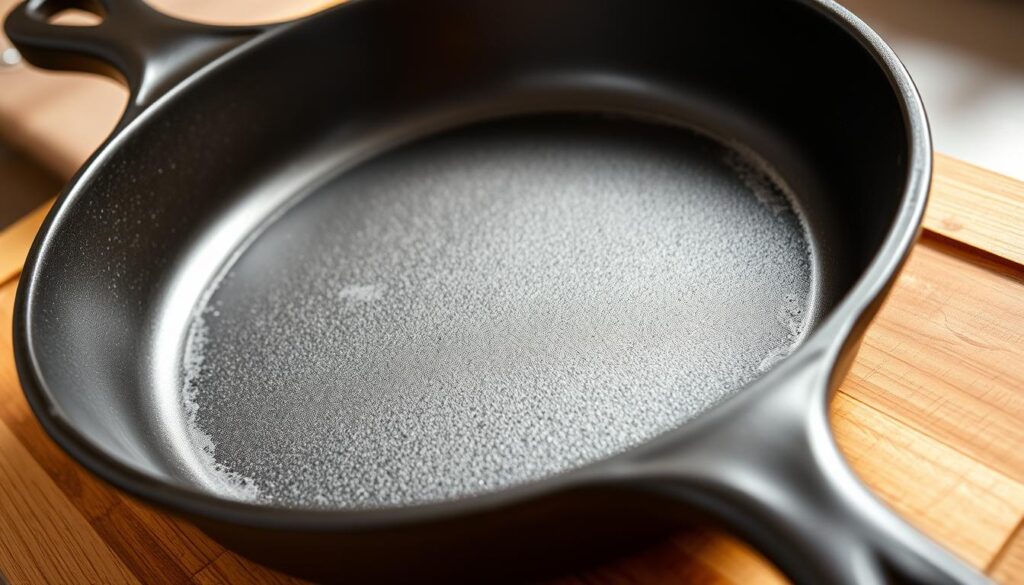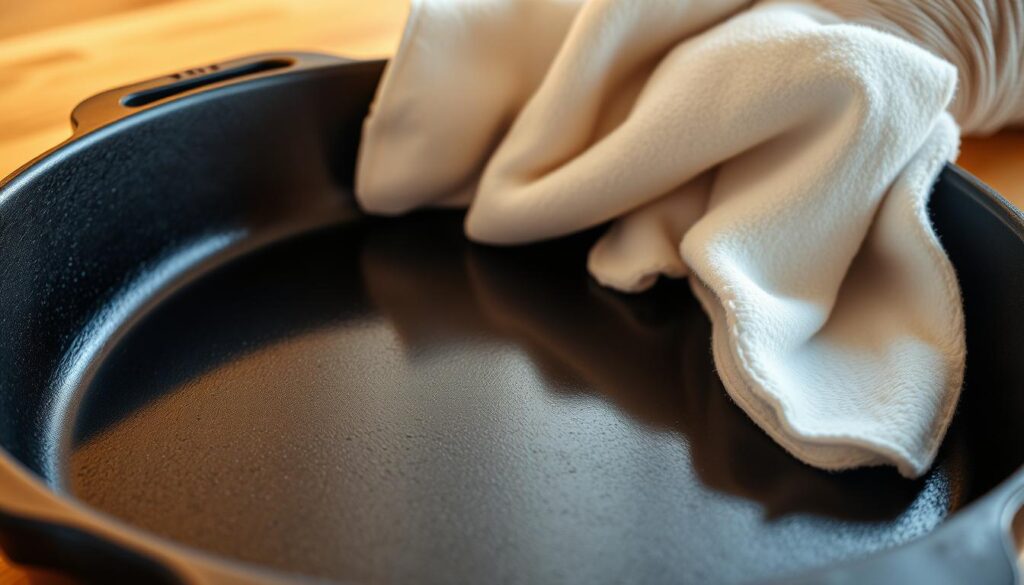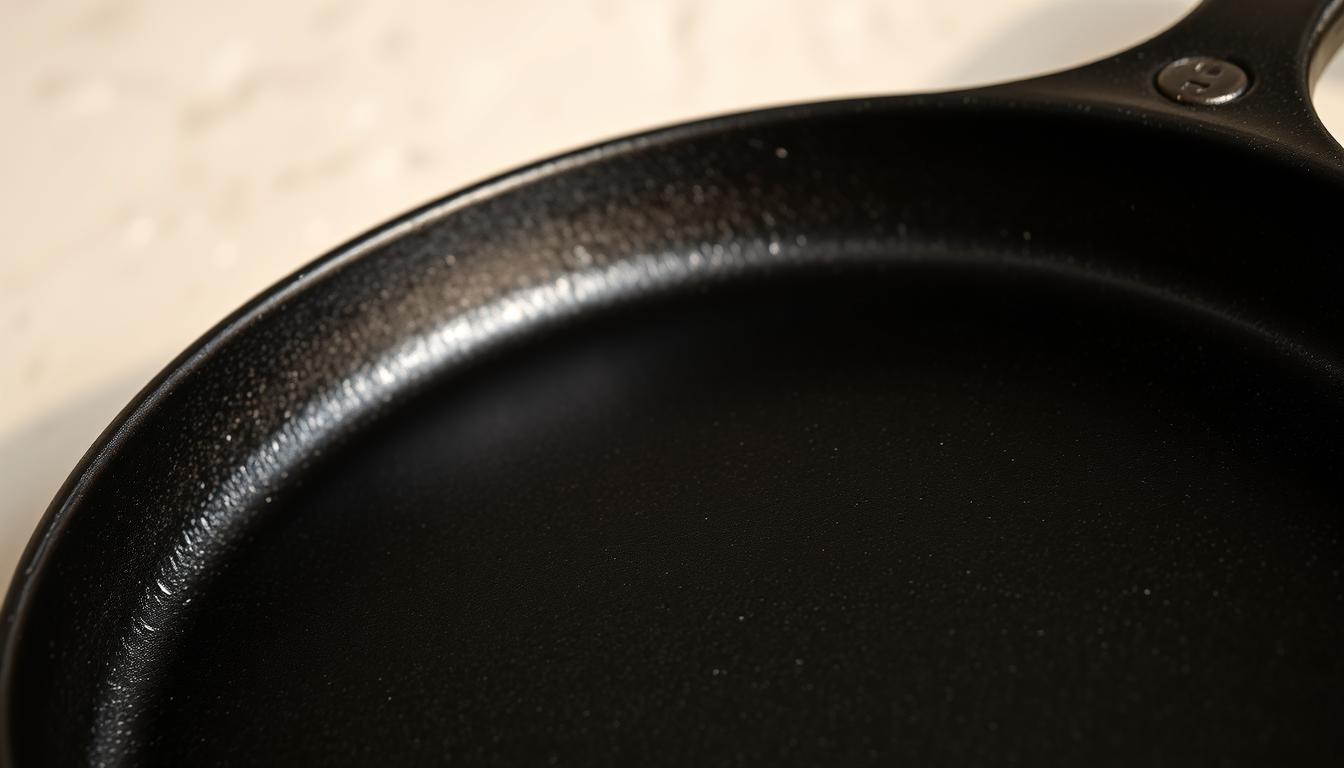You’ve bought a cast iron pan and want to keep it in great shape. It’s important to maintain the seasoning to make sure your pan lasts long. A well-seasoned pan gives you a non-stick surface for cooking many dishes.
Reseasoning your pan is easy. You just need to clean it, apply oil, and bake it in the oven. This method helps restore the seasoning, making your pan non-stick again for your next meal.
Key Takeaways
- Cleaning your pan is the first step in reseasoning.
- Apply a thin, even layer of oil to the pan.
- Bake the pan in the oven to set the seasoning.
- Regular maintenance extends the life of your pan.
- A well-seasoned pan is essential for non-stick cooking.
Why Your Cast Iron Pan Needs Reseasoning
Reseasoning your cast iron pan is crucial for a non-stick surface. The seasoning can wear off from use, cleaning, and storage. Without reseasoning, your pan may lose its non-stick and risk rusting.Cast iron caremeans keeping the seasoning in check. If your pan starts sticking or rusts, it’s time to reseason. This keeps the metal sound and ensures even cooking.
Ignoringcast iron maintenancecan cause rust to damage the metal. This makes your pan unusable. Regular reseasoning prevents these issues and extends your pan’s life.
Adding reseasoning to yourcast iron careis easy and beneficial. It keeps your pan in top shape and improves your cooking. You’ll enjoy a non-stick surface for all your meals.
Knowing the value of reseasoning and making it a habit will let you cook with your cast iron pan for many years.
Understanding Cast Iron Seasoning
The secret to a great cast iron pan is polymerization. When you season a pan, you’re not just putting on oil. You’re making a non-stick coating through a chemical reaction. This happens when you heat the oil to a high temperature, turning it into a hard, non-stick surface.
The cast iron seasoning process keeps your pan in top shape. When you heat the oil, it turns into a tough layer. This layer stops rust and makes sure food doesn’t stick to the pan. It’s why cast iron pans are so popular among cooks.
To get a good seasoning, remember it’s not just about oil. It’s about making a strong, non-stick surface through polymerization. This way, you can cook with your cast iron pan for many years.
Gathering Your Reseasoning Supplies
Before you start reseasoning your cast iron pan, you’ll need a few things. Luckily, you might already have them in your kitchen.
The most important thing you’ll need is cooking oil. Choose a high smoke point oil like vegetable, canola, or peanut oil. These oils can handle high heat without breaking down or smoking.
You’ll also need a soft, lint-free cloth or paper towel for applying oil. And, some aluminum foil or a foil-lined baking sheet to catch drips during reseasoning.
For cast iron care, have mild soap and water ready for cleaning your pan before reseasoning. With these simple reseasoning supplies, you’ll be ready to give your cast iron pan a new seasoning layer and keep it in top shape.
Preparing Your Pan for Reseasoning
To reseason your cast iron pan, start by cleaning it well. Cast iron cleaning removes debris, old food, and old seasoning. This makes the surface ready for new seasoning.
There are a few ways to clean your cast iron pan. One good method is salt scrubbing. It’s gentle but effective in removing grime without harming the pan.
Using Salt Scrubbing Technique
To salt scrub, sprinkle kosher salt or coarse salt into the pan. Add a bit of water to make a paste. Then, scrub the pan with a paper towel or soft sponge. The salt’s grit helps remove food without scratching the iron. Rinse the pan well with warm water.
When to Use Steel Wool
For tough grime or rust, use steel wool. It’s more aggressive than salt scrubbing and can tackle rust or stuck-on debris. But, rinse the pan well after to remove steel wool fibers. Use it sparingly to avoid wearing down the pan’s surface.
Choose your cleaning method wisely. Make sure your pan is clean and dry before reseasoning. This prep work will help create a strong seasoning that protects and improves your cast iron pan’s performance.
Choosing the Best Oil to Reseason Cast Iron
Choosing the right oil for reseasoning your cast iron pan is key. The right oil creates a durable, non-stick surface. This makes cooking better. Cast iron oil is special because it forms a hard, non-stick layer when heated.
For reseasoning, pick an oil with a high smoke point. This is the temperature at which an oil starts to smoke. A high smoke point oil can handle the seasoning process’s high heat without breaking down.
High Smoke Point Oils
Canola, avocado, and grapeseed oils are great for reseasoning. Canola oil has a smoke point of about 400°F (204°C). Avocado oil has a smoke point of around 520°F (271°C) and is good for your heart.
Traditional vs. Modern Oil Options
Older times used lard and beef tallow for seasoning. But now, cooking oil options like vegetable oils and peanut oil are popular. They offer a lighter taste and are easier to find.
The best oil for reseasoning is one that works well and tastes good to you. Choose between traditional or modern oils, but make sure it has a high smoke point for the best results.
How to Reseason Cast Iron Pan the Easy Way
You can easily reseason your cast iron pan at home with just a few simple steps. Reseasoning is a crucial part of cast iron care. It ensures your pan remains non-stick and in good condition.
First, preheat your oven to 350°F (175°C). While the oven is heating up, clean your cast iron pan thoroughly. Use mild soap and water to remove any debris or rust. Avoid using harsh chemicals or scouring pads, as they can damage the pan.

Once your pan is clean, dry it completely with a towel. Then, apply a thin, even layer of oil to the pan. You can use any vegetable oil or cooking spray for this purpose. Make sure to cover the entire surface, including the handle and underside.
Here are the steps to reseason your cast iron pan:
- Place the pan upside down on the middle rack of your oven.
- Place a sheet of aluminum foil on the lower rack to catch any drips.
- Bake the pan for an hour.
- Turn off the oven and let the pan cool completely.
After the pan has cooled, wipe off any excess oil with a paper towel. Your pan is now reseasoned and ready for use. Remember, maintaining your cast iron pan through regular reseasoning is key to its longevity.
By following this easy method of reseasoning, you can keep your cast iron pan in excellent condition. Regular reseasoning cast iron pans not only maintains their non-stick surface but also prevents rust.
Oven Method vs. Stovetop Method: My Honest Opinion
Choosing between oven and stovetop methods for reseasoning your cast iron pan is a big decision. Both have their fans, making it hard to decide. Let’s look at each method to help you choose wisely.
The oven method uses the oven at 450°F (230°C) after oiling the pan. It heats evenly, creating a uniform seasoning. It’s easy because the oven does all the work.
The stovetop method heats the pan on the stovetop or with a torch. It lets you control the heat and is good for upkeep. But, it needs more care and can get messy.
I think the oven method is better for the first seasoning because it heats well. But, the stovetop method is better for small touch-ups. It depends on your pan’s state and what you need.
It’s up to you to decide between oven and stovetop. Your choice should match your pan’s condition and your needs. You might even use both for the best results.
Troubleshooting Common Reseasoning Problems
Dealing with common reseasoning issues is key to keeping your cast iron pan in top shape. Even with the best preparation, problems can still pop up. Knowing how to tackle these issues is vital for a non-stick surface.
Uneven seasoning is a common problem. It might happen if the oil isn’t spread right or if the pan isn’t heated enough. To solve this,re-season the pan, focusing on uneven spots. Make sure to remove any extra oil before heating it up.
Stickiness is another issue. If your pan feels sticky after seasoning, it’s probably because of too much oil.Just wipe off the extra oil with a paper towel and reheat the panto fix it.
Here are some more tips for troubleshooting:
- If you see rust spots, scrub them off with steel wool before seasoning again.
- If the seasoning is peeling off, it could be from bad cleaning or too much heat. Stay away from harsh chemicals or abrasive cleaners.
- For pans with a lot of seasoning, think about stripping the old seasoning before adding a new layer.
By using these troubleshooting tips, you can solve common reseasoning problems. This will help keep your cast iron pan in excellent condition. With regular care and maintenance, your pan will keep performing well for years.
Maintaining Your Newly Seasoned Pan
Keeping your cast iron pan in good shape is easy. After seasoning, it’s important to maintain it regularly. This helps keep the non-stick coating in top condition.
Cleaning your pan is simple. Don’t use harsh chemicals or soap, as they can remove the seasoning. Just wipe it with a paper towel after each use. For stubborn stains, use hot water and a soft sponge.
Cooking with cast iron is more than just making food. It’s also about taking care of your pan. Cooking with a little oil often strengthens the seasoning. This makes the pan even more non-stick over time.

By following these easy steps, you can enjoy your cast iron pan for many years. Regular care is essential for a durable non-stick surface. This makes cooking more enjoyable.
Tips for Long-Term Care: Don’t cook acidic foods in your pan, as they can harm the seasoning. Also, dry your pan well after cleaning. Apply a thin layer of oil to prevent rust.
Foods That Help Build Seasoning Naturally
Cooking with fatty foods is a great way to enhance your cast iron pan’s seasoning. Foods high in fat leave behind a residue that builds and maintains the seasoning layer. This makes your cast iron pan more non-stick and durable over time.
Bacon is one of the best foods you can cook in your cast iron pan because it’s high in fat. The fatty residue from bacon coats the pan, making it non-stick. Cooking bacon in your cast iron pan regularly will greatly improve its performance.
Other Fatty Foods That Work Wonders
Besides bacon, sausages and fatty fish can also build seasoning. Cooking these foods in your cast iron pan makes them taste great and helps season the pan. You can also use oils like avocado oil to enhance the seasoning.
Some other tips to keep in mind:
- Cook at high heat to get a good sear.
- Avoid cooking acidic foods like tomatoes.
- Clean your pan properly after each use.
By following these tips and cooking the right foods, you’ll maintain a strong seasoning on your cast iron pan.
When to Reseason Again: Creating a Maintenance Schedule
To keep your cast iron pan in top shape, setting up a reseasoning schedule is key. How often you need to reseason depends on how much you use it.
Factors to Consider: If you cook with your cast iron pan every day, you might need to reseason it every 1-3 months. But, if it sits idle for longer periods, you could go 6-12 months without needing to reseason it.
- Food starts to stick to the surface
- The pan’s non-stick coating appears worn off
- You notice rust spots
To keep your cast iron pan’s non-stick surface, clean it well after each use and dry it completely. Stay away from harsh chemicals or abrasive cleaners. They can damage the seasoning.
By following a maintenance plan and keeping an eye on your pan’s condition, you can make it last longer. This ensures it continues to cook well.
Conclusion
Proper cast iron care is more than just cooking. It’s about keeping your pan in great shape. Regular reseasoning is key to maintain the non-stick coating.
By following the steps in this article, you’ve started to care for your cast iron pan. Remember, regular care is essential. Avoid harsh chemicals, don’t put it in the dishwasher, and reseason when needed.
A well-cared-for cast iron pan can last for decades. It will give you many meals and cooking experiences. With a bit of effort, you’ll enjoy a durable non-stick coating. It makes cooking and cleaning easy. Whether you’re experienced or new to cooking, a well-maintained cast iron pan is a valuable asset.
If you want to read the full post about how to get started with cast iron, then read this article next.
Some of the images may have been created with the help of AI.
FAQ
What is reseasoning a cast iron pan?
Reseasoning a cast iron pan means adding a new layer of seasoning. This keeps the pan non-stick and prevents rust.
Why do I need to reseason my cast iron pan?
Reseasoning keeps your pan non-stick and prevents rust. It also ensures your pan works well.
What type of oil is best for reseasoning a cast iron pan?
Use oils like vegetable, canola, or peanut oil. They handle high heat without breaking down.
Can I use any type of cooking oil to reseason my cast iron pan?
No, avoid oils like olive or coconut oil. They can become sticky when heated.
How often should I reseason my cast iron pan?
Reseason every 1-3 months, depending on use and maintenance. This keeps your pan in top shape.
Can I reseason my cast iron pan in the oven or on the stovetop?
Yes, you can use the oven or stovetop. The oven method is often easier and more convenient.
What are some common problems that can occur during reseasoning?
Issues like uneven seasoning, sticky spots, and rust can happen. Clean and prepare the pan well to avoid these problems.
How do I maintain my newly seasoned cast iron pan?
Avoid harsh cleaners and dry the pan well after cleaning. Cooking with fatty foods helps keep the seasoning.
What foods can help build seasoning naturally?
Foods like bacon deposit oil on the pan. This helps build seasoning naturally.
Can I put my cast iron pan in the dishwasher?
No, the dishwasher’s heat and chemicals can damage the seasoning. This can lead to rust.

View comments
+ Leave a comment